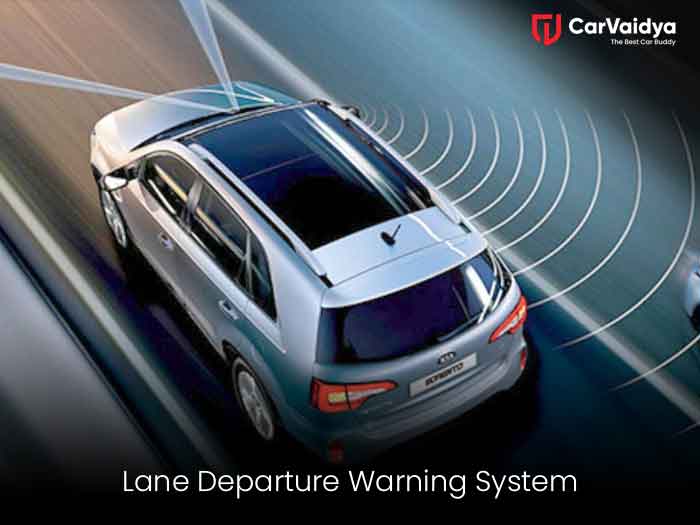Lane Departure Warning Systems

 By CarVaidya
By CarVaidya- 04 Feb 2024
Lane Departure Warning Systems
In recent years, automotive technology has witnessed remarkable advancements aimed at enhancing safety and reducing the risk of accidents on the roads. One such significant safety feature integrated into modern cars is the Lane Departure Warning (LDW) system. This innovative technology plays a crucial role in preventing accidents by alerting drivers when they unintentionally deviate from their lane. In this article, we will delve into the workings of Lane Departure Warning systems, their effectiveness, and their contribution to road safety.
Understanding Lane Departure Warning Systems
Lane Departure Warning systems utilize sophisticated sensors and cameras to monitor the vehicle's position within its lane. These systems work in real-time, constantly analyzing the road markings and the car's position relative to those markings. When the system detects that the vehicle is unintentionally drifting out of its lane, it triggers an alert to notify the driver. The alert can be in the form of visual warnings, auditory signals, or even steering wheel vibrations.
II. Operating Mechanism
A. Sensors and Cameras
LDW systems primarily rely on advanced sensors and cameras installed in the vehicle. These sensors continuously capture data about the road markings and the car's position on the road. The cameras can recognize lane boundaries, and the sensors track the vehicle's movements within those boundaries.
B. Real-time Analysis
The collected data undergoes real-time analysis by the onboard computer. The system uses algorithms to assess whether the car is maintaining its lane properly. If the algorithms detect any deviation without the use of turn signals, it activates the warning system.
III. Types of Alerts
A. Visual Alerts
Visual alerts are typically displayed on the vehicle's dashboard or in the instrument cluster. These alerts can take the form of a flashing light, an icon indicating the lane departure, or a message instructing the driver to take corrective action.
B. Auditory Signals
Auditory signals include beeps, chimes, or other sound notifications that grab the driver's attention. These alerts are designed to be distinct and attention-grabbing, ensuring that the driver is promptly aware of the lane departure.
C. Haptic Feedback
Some vehicles equipped with advanced LDW systems provide haptic feedback through the steering wheel. If the system detects lane departure, the steering wheel may vibrate, providing a tactile warning to the driver.
IV. Effectiveness of Lane Departure Warning Systems
A. Accident Prevention
One of the primary objectives of Lane Departure Warning systems is to prevent accidents caused by unintentional lane departure. By alerting the driver promptly, these systems provide an opportunity for corrective action before a potential collision occurs.
B. Reduction in Fatigue-related Accidents
Long hours of driving can lead to driver fatigue, increasing the likelihood of lapses in attention. LDW systems act as an additional safety net, helping drivers stay focused on the road and minimizing the risk of accidents due to fatigue-induced lane drifting.
C. Improved Safety in Challenging Conditions
LDW systems prove especially beneficial in adverse weather conditions, such as heavy rain or snow, where visibility may be compromised. The technology remains effective, providing warnings even when road markings are not clearly visible.
V. Challenges and Limitations
While Lane Departure Warning systems offer significant safety benefits, it's essential to acknowledge their limitations and challenges:
A. False Positives
LDW systems may occasionally generate false positives, triggering alerts when the lane departure was intentional, such as during lane changes with proper signaling. This can lead to driver annoyance and potentially cause distraction.
B. Limited Effectiveness in Certain Scenarios
These systems may be less effective on poorly marked roads or in situations where road markings are faded or obscured. Additionally, sharp curves or sudden lane changes may pose challenges for the system to accurately predict lane departure.
C. Dependency on Driver Attention
LDW systems are designed as assistive technologies and not substitutes for attentive driving. Their effectiveness relies on the driver's responsiveness to the warnings and their ability to take appropriate corrective action.
VI. Integration with Other Safety Features
To enhance overall vehicle safety, many modern cars integrate LDW systems with other advanced safety features, creating a comprehensive safety suite. Some of these features include
A. Lane Keeping Assist
Lane Keeping Assist (LKA) is an extension of LDW that actively intervenes to guide the vehicle back into its lane if the driver does not respond to the initial warning. This feature enhances the corrective actions taken by the driver.
B. Adaptive Cruise Control
LDW systems can work in conjunction with Adaptive Cruise Control (ACC) to maintain a safe following distance and prevent collisions. The integration of these features contributes to a more advanced and responsive driving experience.
C. Collision Avoidance Systems
In some vehicles, LDW systems are part of a broader Collision Avoidance System, which combines various technologies to prevent collisions and minimize the severity of impact if a collision is unavoidable.
VII. Future Developments and Innovations
As automotive technology continues to advance, Lane Departure Warning systems are expected to evolve with new features and improved accuracy. Some potential developments include.
A. Artificial Intelligence Integration
The integration of artificial intelligence (AI) could enhance the ability of LDW systems to adapt to diverse driving conditions and improve their accuracy in detecting lane departures.
B. Enhanced Sensor Technology
Future systems may incorporate more advanced sensors, such as LiDAR (Light Detection and Ranging) and radar, to further improve the precision of lane departure detection.
C. Vehicle-to-Everything (V2X) Communication
V2X communication involves vehicles sharing data with each other and with infrastructure elements. Integrating LDW systems with V2X technology could enable more comprehensive and proactive warnings based on real-time data exchange.
Conclusion
Lane Departure Warning systems represent a significant stride in automotive safety, providing drivers with valuable assistance in preventing accidents caused by unintentional lane departure. While these systems are not without limitations, their effectiveness in enhancing road safety cannot be overstated. As technology continues to advance, the integration of LDW systems with other safety features and the incorporation of emerging technologies promise a future where road travel becomes even safer. As drivers, manufacturers, and regulators collectively embrace these innovations, the vision of accident-free roads moves closer to reality.
You can read some other articles also
Understanding the main causes of fogging on windshields while driving in
The significance of vehicle registration plate colors
The advantage of automatic climate control in vehicles




0 Comments